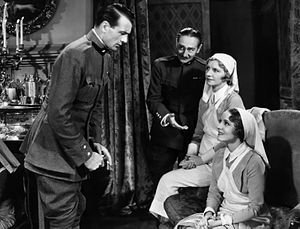
In a movie a medium shot, mid shot (MS), or waist shot is a camera angle shot from a medium distance.
Use
Medium shots are favored in sequences where dialogues or a small group of people are acting, as they give the viewer a partial view of the background, such as when the shot is 'cutting the person in half' and also show the subjects' facial expressions in the context of their body language. Medium shots are also used when the subject in the shot is delivering information, such as news presenters. It is also used in interviews. It is the most common shot in movies, and it usually follows the first establishing shots of a new scene or location.
A normal lens that sees what the human eye sees is usually used for medium shots.
Definition

The medium shot shows equality between subjects and background. The dividing line between what constitutes a long shot and medium shot is not definite, nor is the line between medium shot and close-up. In some standard texts and professional references, a full-length view of a human subject is called a medium shot; in this terminology, a shot of the person from the knees up or the waist up is a close-up shot. In other texts, these partial views are called medium shots. In principle, the medium shot is what can be seen with the human eye in a single quick glance and convey all the action taking place in that field of view.
Types
Medium shots are divided into singles (a waist-high shot of one actor), group shots, over-the shoulders or two-shots (featuring two people). A medium wide shot, or American shot, shows a bit more of the background but is still close enough for facial expressions to be seen, although these facial expressions would be better seen in a waist-high shot.
See also
- Camera angle
- Camera operator
- Close-up
- Dutch angle
- Establishing shot
- High-angle shot
- Long shot
- Low-angle shot
- Mise-en-scène
- Over the shoulder shot
- Two shot
- Video production
- Videographer
References
- Brown, Blain (2012). Cinematography: Theory and Practice, Image Making for Cinematographers and Directors. Burlington, Massachusetts: Focal Press. p. 20. ISBN 9781136047381. Retrieved August 11, 2023.
- ^ "Mid Shot (MS)". mediacollege.com. Wavelength Media. Retrieved 2015-12-01.
- ^ "Basics of video shooting". asu.edu. Arizona State University. Retrieved 2015-12-01.
- ^ "medium shot". www.dictionary.com. Dictionary.com. Retrieved 1 December 2015.
- Ablan, Dan. "Medium Shots". www.peachpit.com. Peachpit. Retrieved 1 December 2015.
- ^ Alexander, Victor. "Long shot, medium shot, close-up". www.releasing.net. Releasing.net. Archived from the original on December 23, 2019. Retrieved 1 December 2015.
- ^ Moura, Gabe (3 June 2014). "SHOT SIZES: Telling What They See". www.elementsofcinema.com. Gabriel Moura. Retrieved 1 December 2015.
- Moura, Gabe (3 June 2014). "Types of Lenses". www.elementsofcinema.com. Gabriel Moura. Retrieved 1 December 2015.
- "Film Glossary". www.owlnet.rice.edu. Rice University. Retrieved 1 December 2015.
- "Elements of Cinematography: Camera". www.utdallas.edu. University of Texas at Dallas. Retrieved 1 December 2015.
Further reading
- Ablan, Dan (2002). Digital Cinematography & Directing. Peachpit. ISBN 0-7357-1258-1.
- Alexander, Victor (29 May 2008). Filmmaking A to Z: The Guide to 35 Millimeter Filmmaking. Victor Alexander. ISBN 978-1-4382-0963-0.
| Cinematic techniques | |||||||||||||||
|---|---|---|---|---|---|---|---|---|---|---|---|---|---|---|---|
| Lighting | |||||||||||||||
| Sound | |||||||||||||||
| Shooting |
| ||||||||||||||
|
| |||||||||||||||